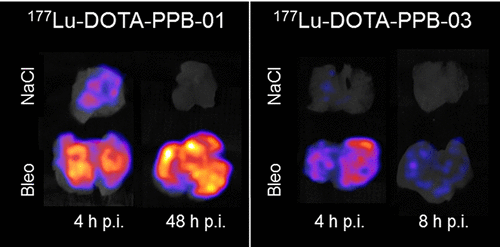当前位置:
X-MOL 学术
›
Mol. Pharmaceutics
›
论文详情
Our official English website, www.x-mol.net, welcomes your
feedback! (Note: you will need to create a separate account there.)
In Vivo Labeling of Plasma Proteins for Imaging of Enhanced Vascular Permeability in the Lungs
Molecular Pharmaceutics ( IF 4.5 ) Pub Date : 2018-09-28 00:00:00 , DOI: 10.1021/acs.molpharmaceut.8b00606 Janine Schniering 1 , Francesca Borgna 2, 3 , Klaudia Siwowska 2 , Martina Benešová 2, 4 , Susan Cohrs 2 , Roger Hasler 2 , Nicholas P. van der Meulen 2, 5 , Britta Maurer 1 , Roger Schibli 2, 4 , Cristina Müller 2, 4
Molecular Pharmaceutics ( IF 4.5 ) Pub Date : 2018-09-28 00:00:00 , DOI: 10.1021/acs.molpharmaceut.8b00606 Janine Schniering 1 , Francesca Borgna 2, 3 , Klaudia Siwowska 2 , Martina Benešová 2, 4 , Susan Cohrs 2 , Roger Hasler 2 , Nicholas P. van der Meulen 2, 5 , Britta Maurer 1 , Roger Schibli 2, 4 , Cristina Müller 2, 4
Affiliation

|
Increased vascular permeability is an important hallmark of many diseases, including cancer, cerebral ischemia, and severe inflammatory disorders. In this regard, the noninvasive assessment of pathologically increased vascular permeability in vivo is of great interest. In this study, the potential of albumin- and transthyretin-binding radioligands was evaluated for imaging of vascular hyperpermeability. For this purpose, the bleomycin-induced lung injury model was used as a model of inflammation-associated vascular leakage. The plasma protein-binding ligands, which bind to albumin (DOTA-PPB-01) and transthyretin (DOTA-PPB-03), were radiolabeled and used for nuclear imaging and biodistribution studies. In this regard, 177Lu was employed as a surrogate nuclide for detailed preclinical investigations, including single-photon emission computed tomography (SPECT) studies, whereas 44Sc was proposed as a radionuclide for positron emission tomography (PET), which may be relevant for future clinical translation. Mice were administered with these radioligands 6–9 days after intratracheal instillation of bleomycin or saline. Bleomycin-treated mice developed pronounced lung inflammation with enhanced vascular permeability that was reflected in significantly increased lung size and weight due to edema and infiltration with inflammatory cells. Biodistribution studies revealed significantly higher accumulation of 177Lu-DOTA-PPB-01 in injured lungs as compared to lungs of control animals at all investigated time points (4–48 h p.i.). The best contrast was achieved at late time points (16.1 ± 2.91% IA/g vs 2.03 ± 1.22% IA/g, 48 h p.i.) when the blood activity levels were ∼7.5% IA/g. Injection of 177Lu-DOTA-PPB-03 also resulted in increased lung accumulation in bleomycin-treated mice at all investigated time points (2–8 h p.i.). The pharmacokinetics was significantly faster, however, resulting in good contrast already at 8 h p.i. (4.32 ± 0.85% IA/g vs 1.06 ± 0.10% IA/g) when blood activity levels were ∼2% IA/g. The absolute lung accumulation of 177Lu-DOTA-PPB-03 was significantly lower than that of 177Lu-DOTA-PPB-01. PET/CT scans performed with 44Sc-DOTA-PPB-01 distinguished injured from healthy lungs only at late time points (20 h p.i.), whereas 44Sc-DOTA-PPB-03 already allowed the differentiation at 4 h p.i. due to its faster clearance. The investigated radioligands, 44Sc/177Lu-DOTA-PPB-01 and 44Sc/177Lu-DOTA-PPB-03, hold promise for the visualization of vascular leakage in a variety of pathological conditions. 44Sc would be the radionuclide of choice for clinical application as it can be stably coordinated with a DOTA chelator and enables PET imaging over extended periods.
中文翻译:

血浆蛋白的体内标记,用于肺部增强的血管通透性成像
血管通透性增加是许多疾病的重要标志,包括癌症,脑缺血和严重的炎症性疾病。在这方面,对体内病理性增加的血管通透性的非侵入性评估非常感兴趣。在这项研究中,评估了结合白蛋白和运甲状腺素蛋白的放射性配体对血管通透性成像的潜力。为此,将博来霉素诱导的肺损伤模型用作与炎症相关的血管渗漏的模型。结合白蛋白(DOTA-PPB-01)和运甲状腺素蛋白(DOTA-PPB-03)的血浆蛋白结合配体经过放射性标记,并用于核成像和生物分布研究。在这方面,177Lu被用作替代核素,用于详细的临床前研究,包括单光子发射计算机断层扫描(SPECT)研究,而44 Sc被提议作为正电子发射断层摄影(PET)的放射性核素,这可能与将来的临床翻译有关。气管内滴注博来霉素或生理盐水后6-9天,给小鼠施用这些放射性配体。经博来霉素治疗的小鼠出现明显的肺部炎症,血管通透性增强,这反映为由于水肿和炎性细胞浸润导致肺部大小和重量显着增加。生物分布研究表明177的积聚明显更高在所有调查的时间点(感染后4–48小时),与对照组动物的肺相比,Lu-DOTA-PPB-01在受伤的肺中。当血液活性水平为〜7.5%IA / g时,在较晚的时间点(16.1±2.91%IA / g与2.03±1.22%IA / g,pi 48小时)达到最佳对比。注射177 Lu-DOTA-PPB-03也导致在所有调查的时间点(注射后2-8小时),博来霉素治疗的小鼠的肺部蓄积增加。药代动力学显着加快,但是,当血液活性水平约为2%IA / g时,在pi 8 h时就已经产生了良好的对比度(4.32±0.85%IA / g与1.06±0.10%IA / g)。177 Lu-DOTA-PPB-03的绝对肺累积量明显低于177 Lu-DOTA-PPB-01的绝对肺累积量。使用44台PET / CT扫描Sc-DOTA-PPB-01仅在较晚的时间点(感染后20小时)才将健康肺脏与受伤的肺区分开,而44个Sc-DOTA-PPB-03由于其清除速度更快,已经允许在感染后4 h分化。研究的放射性配体44 Sc / 177 Lu-DOTA-PPB-01和44 Sc / 177 Lu-DOTA-PPB-03,有望在各种病理情况下可视化血管渗漏。44 Sc将是临床应用的首选放射性核素,因为它可以与DOTA螯合剂稳定配合,并可以长时间进行PET成像。
更新日期:2018-09-28
中文翻译:

血浆蛋白的体内标记,用于肺部增强的血管通透性成像
血管通透性增加是许多疾病的重要标志,包括癌症,脑缺血和严重的炎症性疾病。在这方面,对体内病理性增加的血管通透性的非侵入性评估非常感兴趣。在这项研究中,评估了结合白蛋白和运甲状腺素蛋白的放射性配体对血管通透性成像的潜力。为此,将博来霉素诱导的肺损伤模型用作与炎症相关的血管渗漏的模型。结合白蛋白(DOTA-PPB-01)和运甲状腺素蛋白(DOTA-PPB-03)的血浆蛋白结合配体经过放射性标记,并用于核成像和生物分布研究。在这方面,177Lu被用作替代核素,用于详细的临床前研究,包括单光子发射计算机断层扫描(SPECT)研究,而44 Sc被提议作为正电子发射断层摄影(PET)的放射性核素,这可能与将来的临床翻译有关。气管内滴注博来霉素或生理盐水后6-9天,给小鼠施用这些放射性配体。经博来霉素治疗的小鼠出现明显的肺部炎症,血管通透性增强,这反映为由于水肿和炎性细胞浸润导致肺部大小和重量显着增加。生物分布研究表明177的积聚明显更高在所有调查的时间点(感染后4–48小时),与对照组动物的肺相比,Lu-DOTA-PPB-01在受伤的肺中。当血液活性水平为〜7.5%IA / g时,在较晚的时间点(16.1±2.91%IA / g与2.03±1.22%IA / g,pi 48小时)达到最佳对比。注射177 Lu-DOTA-PPB-03也导致在所有调查的时间点(注射后2-8小时),博来霉素治疗的小鼠的肺部蓄积增加。药代动力学显着加快,但是,当血液活性水平约为2%IA / g时,在pi 8 h时就已经产生了良好的对比度(4.32±0.85%IA / g与1.06±0.10%IA / g)。177 Lu-DOTA-PPB-03的绝对肺累积量明显低于177 Lu-DOTA-PPB-01的绝对肺累积量。使用44台PET / CT扫描Sc-DOTA-PPB-01仅在较晚的时间点(感染后20小时)才将健康肺脏与受伤的肺区分开,而44个Sc-DOTA-PPB-03由于其清除速度更快,已经允许在感染后4 h分化。研究的放射性配体44 Sc / 177 Lu-DOTA-PPB-01和44 Sc / 177 Lu-DOTA-PPB-03,有望在各种病理情况下可视化血管渗漏。44 Sc将是临床应用的首选放射性核素,因为它可以与DOTA螯合剂稳定配合,并可以长时间进行PET成像。











































 京公网安备 11010802027423号
京公网安备 11010802027423号